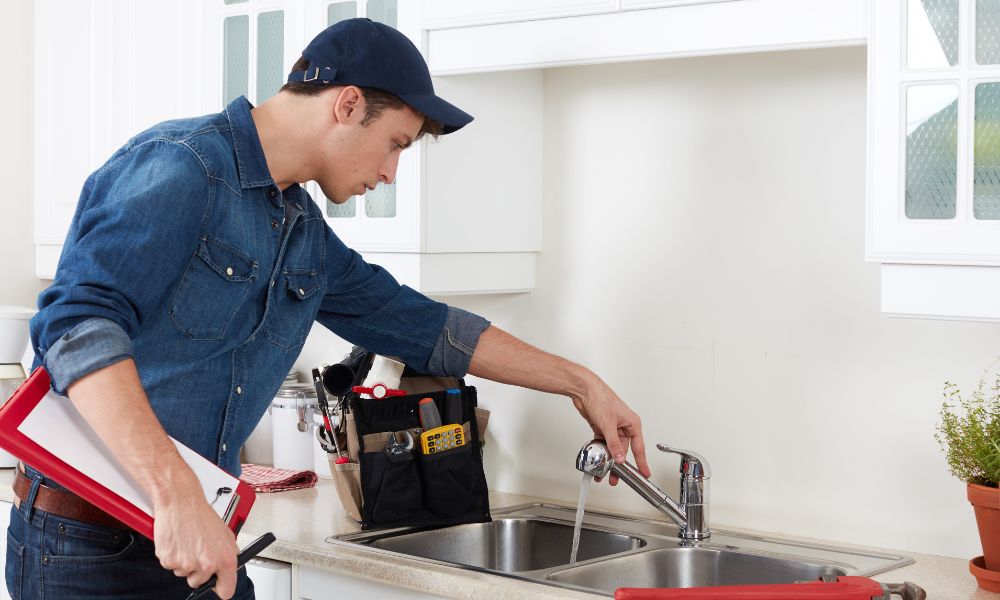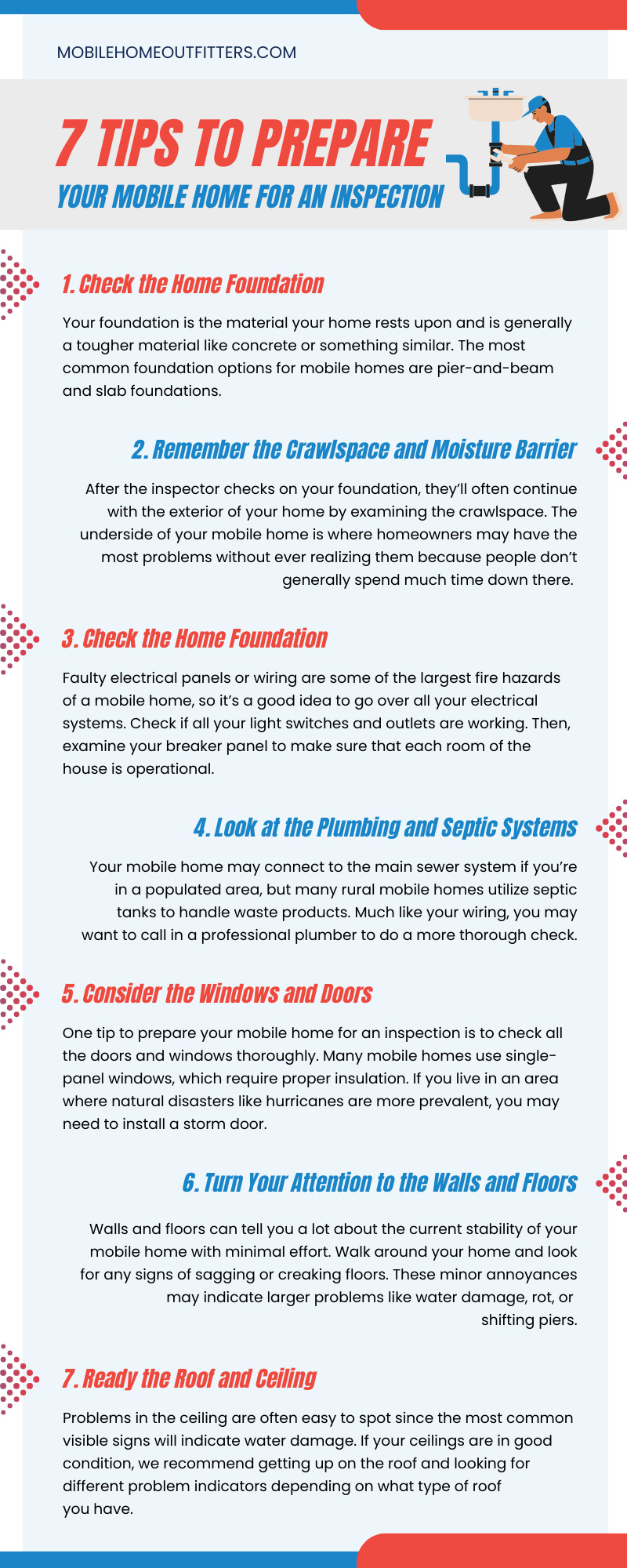
Mobile homes are a wonderful and affordable alternative to more traditional housing. You can customize your mobile home to suit your style and comfort needs and create your ideal environment. However, like other types of housing, your home must pass an inspection to ensure that it’s safe for habitation.
The specific rules and regulations regarding the outcome of these inspections may vary depending on your state, county, or even city, so it’s always a good idea to brush up on local laws. However, here are seven tips to prepare your mobile home for an inspection. These tips will help give you a rough idea of the most common problem areas in mobile homes and what type of work an inspector may consider when the time comes to approve your home.
1. Check the Home Foundation
The mobile home foundation is one of the biggest things that separates it from other housing options. Naturally, it makes sense that the foundation is one of the first things an inspector will look at. Your foundation is the material your home rests upon and is generally a tougher material like concrete or something similar. The most common foundation options for mobile homes are pier-and-beam and slab foundations.
A pier-and-beam foundation is a large frame with several internal beams that help provide the necessary support throughout your mobile home. You want to place the internal beams around 8 to 10 feet apart and securely fasten them to the ground with anchors. This type of foundation is affordable and easier to set up, but many homeowners find it doesn't work in the long run. A pier-and-beam foundation is more likely to sink into the ground on one side over time and may require additional work in the long run.
A slab foundation is a large solid piece of concrete that connects to the ground with anchors. Homeowners can use insulation to warm the ground layer and hopefully provide a more comfortable temperature in the home. One of the downsides of a slab foundation is that it's more difficult to install if your home is on a slope, and the lack of insulation may make it more challenging to pass your inspection. Regardless of which type you have, check that it’s in good condition.
2. Remember the Crawlspace and Moisture Barrier
After the inspector checks on your foundation, they’ll often continue with the exterior of your home by examining the crawlspace. The underside of your mobile home is where homeowners may have the most problems without ever realizing them because people don’t generally spend much time down there. Some of the largest issues are mold and rot that develop due to humidity. The best way to protect the underside of your mobile home is via a proper skirting kit with appropriate ventilation.
Before your inspection, we recommend examining your moisture barrier. This barrier is a thin sheet of plastic like polyethylene that works to keep moisture from getting into your framework. Checking that this barrier is in good condition with no rips, tears, or signs of sagging may prove beneficial for your home inspection.
3. Think About the Electrical Wiring
Faulty electrical panels or wiring are some of the largest fire hazards of a mobile home, so it’s a good idea to go over all your electrical systems. Check if all your light switches and outlets are working. Then, examine your breaker panel to make sure that each room of the house is operational. If your system is working and you don't have any fraying wires, your electrical system should pass inspection. Some homeowners may hire an electrician to come to do a thorough examination of their own before calling over the home inspector.
4. Look at the Plumbing and Septic Systems
Your mobile home may connect to the main sewer system if you’re in a populated area, but many rural mobile homes utilize septic tanks to handle waste products. Much like your wiring, you may want to call in a professional plumber to do a more thorough check. However, you can keep an eye out for common issues like leaking faucets, low water pressure, wobbling toilets, and any visual signs of water damage on your walls.
5. Consider the Windows and Doors
One tip to prepare your mobile home for an inspection is to check all the doors and windows thoroughly. Many mobile homes use single-panel windows, which require proper insulation. If you live in an area where natural disasters like hurricanes are more prevalent, you may need to install a storm door. Check that all your windows and doors can open and close without issue, as jammed doors or windows may result from improper alignment or crooked hinges.
6. Turn Your Attention to the Walls and Floors
Walls and floors can tell you a lot about the current stability of your mobile home with minimal effort. Walk around your home and look for any signs of sagging or creaking floors. These minor annoyances may indicate larger problems like water damage, rot, or shifting piers. Discovering the issues where you normally walk around may make it easier to examine for further problems in the crawlspace since you know where to look.
Going through your home and gently pushing on your walls is always a good idea. You want to ensure they feel sturdy and don't cause any wobbling when you press on them. The type of siding you have on your mobile home can help give you a better idea of where the problem areas may lie with your walls. For example, hardwood siding is more likely to leak at the seams, while metal siding may have issues around doors and windows.
7. Ready the Roof and Ceiling
Problems in the ceiling are often easy to spot since the most common visible signs will indicate water damage. If your ceilings are in good condition, we recommend getting up on the roof and looking for different problem indicators depending on what type of roof you have. Typically, you want to ensure that there are no missing tiles or shingles and that everything is as watertight as possible. If you have a metal roof, you may want to look for any signs of rust, dents, or corrosion, which may lead to problems with your home inspection.
If you need help getting your home ready for inspection, you should get in touch with Mobile Home Outfitters. We have a wide selection of replacement parts and features for every room in your home. If you need specific tips for upgrading your home, our blog has several helpful tips to enhance the interior and exterior of your home. To ensure that you have the best skirting option to protect your crawlspace and foundation, consider using our mobile home underpinning calculator. It’ll help you get the right kit in the right size. If you have any additional questions, comments, or concerns, don’t be afraid to contact us. A helpful member of our staff will be glad to assist you.


